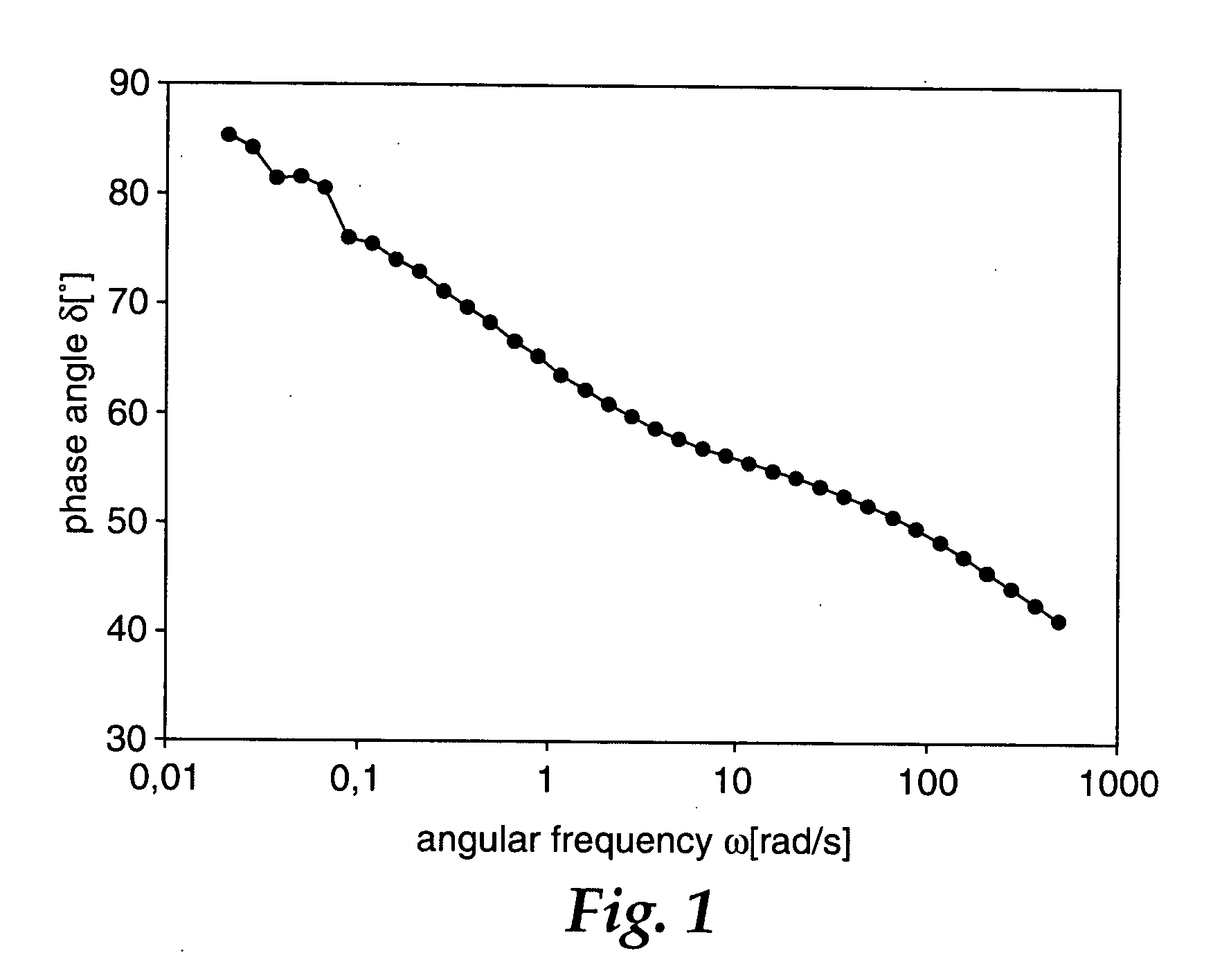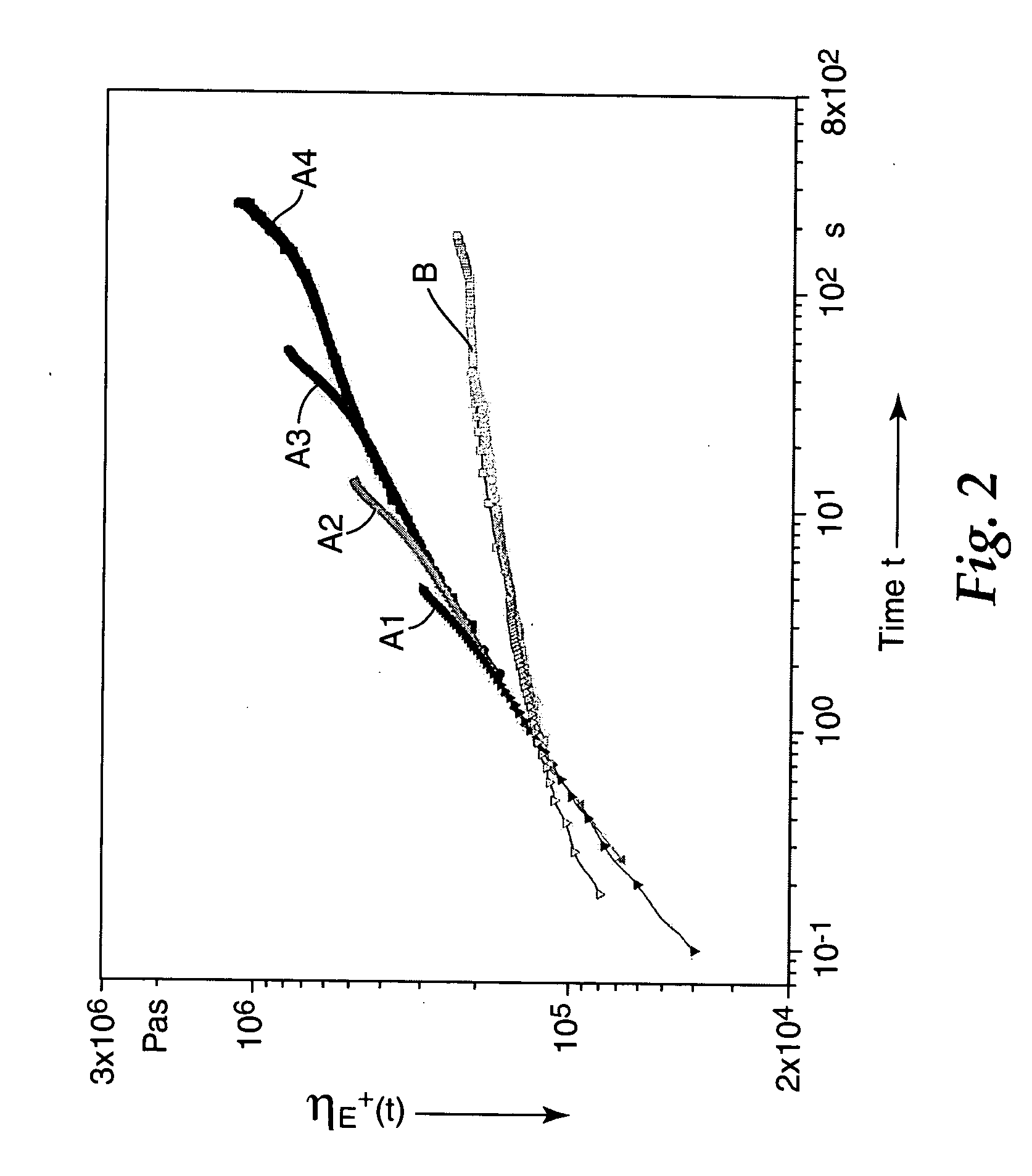Melt-processible thermoplastic fluoropolymers having improved processing characteristics and method of producing same
- Summary
- Abstract
- Description
- Claims
- Application Information
AI Technical Summary
Benefits of technology
Problems solved by technology
Method used
Image
Examples
example 1
Comparative Example
[0064] A copolymer of TFE, HFP and VDF was prepared as follows: A polymerization kettle with a total volume of 47.5 1 equipped with an impeller agitator system was charged with 29.01 deionized water; 2 g oxalic acid, 12 g ammonium oxalate and 252 g of a 30 weight % aqueous solution of perfluorooctanoate ammonium salt (FX 1006 of 3M Company, APFO). The oxygen free kettle was then heated up to 60.degree. C. and the agitation system was set to 240 rpm. The kettle was charged with ethane to a pressure of 1.1 bar absolute, 847 g hexafluoropropylene (HFP) to a pressure of 8.4 bar absolute, with 253 g vinylidenefluoride (VDF) to 12.8 bar absolute and with 425 g tetrafluorethylene (TFE) to 16.8 bar absolute reaction pressure. The polymerization was initiated by the addition of 25 ml 1.31% aqueous potassium permanganate (KMnO.sub.4) solution and a continuous feed of KMnO.sub.4-solution was maintained with a feed rate of 60 ml / h. As the reaction starts, the reaction tempera...
example 2
[0068] In this example, a terpolymer having the same composition as in comparative example 1, was produced essentially according to the procedure of example 1 but using the olefin BDFE. The kettle was charged with ethane to a pressure of 1.8 bar absolute and 790 g hexafluoropropylene (HFP) to a pressure of 8.5 bar absolute, the stainless steel cylinder with a total volume of 5.3 l used as feeding line for HFP was fully evacuated. After complete evacuation, the cylinder was charged with 400 mbar of BDFE, which corresponds to 12.3 g at room temperature according to the ideal gas law. Then the cylinder was rapidly charged with 2850 g HFP in order to ensure a sufficient dispersion of BDFE into HFP under turbulent flow conditions. The rest of the polymerization was conducted in the same manner as described in example 1. The polymerization took 170 min to obtain polymer dispersion having a solid content of 33.8% and a latex particles having 110 nm in diameter according to dynamic light sc...
example 3
[0071] The polymers of examples 1 and 2 were investigated at 170.degree. C. in terms of their strain hardening behavior using a Mu nstedt elongational rheometer (described above). At 170.degree. C., the semicrystalline terpolymer is completely melted. The elongational viscosity for both samples as a function of elongational rate and time was investigated. In FIG. 2, curves A1 to A4 represent the behavior of the polymer of example 2 at different elongational rates of respectively 0.5, 0.2, 0.05 and 0.01 and curves B represent the behavior for the polymer of example 1 whereby the curves at different elongational rates collide with each other. As can be seen from FIG. 2, in the whole regime of elongational rates and time, the elongational viscosity of the comparative polymer of example 1 describes a curve which is typical for the initial phase of a creep experiment. There are no implications of strain hardening.
[0072] At low times, the elongational viscosities of the polymer example 2 ...
PUM
| Property | Measurement | Unit |
|---|---|---|
| Temperature | aaaaa | aaaaa |
| Temperature | aaaaa | aaaaa |
| Percent by mass | aaaaa | aaaaa |
Abstract
Description
Claims
Application Information
 Login to View More
Login to View More - R&D
- Intellectual Property
- Life Sciences
- Materials
- Tech Scout
- Unparalleled Data Quality
- Higher Quality Content
- 60% Fewer Hallucinations
Browse by: Latest US Patents, China's latest patents, Technical Efficacy Thesaurus, Application Domain, Technology Topic, Popular Technical Reports.
© 2025 PatSnap. All rights reserved.Legal|Privacy policy|Modern Slavery Act Transparency Statement|Sitemap|About US| Contact US: help@patsnap.com



